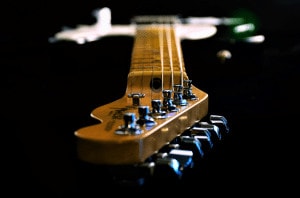Look, Fender Jaguar vs Jazzmaster is the epic final battle. It’s the Super Bowl. Stanley Cup Final, Game 7. Yes, they are widely known as Fender’s best offset guitars and in this article, they’re going head to head. Dragon Ball Z style.

Author: Santiago Motto
Aka. Sandel. Telecasters and all-mahogany Martins lover.
Besides that, Sandel is a professional writer, guitar player, confessed guitar nerd, and all-things-guitar consumer. He has been playing for 25 years which makes him a nineties kid with serious low-tuning youngster years, and a pop palate for melodies, ballads, and world music.
Whenever Santiago is not pouring all that experience and love for the instrument into articles, you can find him playing live shows supporting his music and poetry books as “Sandel”. If he’s not doing either of those, you can also find him gigging with his band, “San Juan”, writing, reading, or enjoying the Sun.

Editor: Edward Bond
Edward has been playing the guitar since 2002. So Edward has over 20 years of experience as a guitarist, has authored 15 guitar books, has written for renowned music blogs, and spent a decade teaching music. He began merging his passion for writing and music in 2020 and has written for big guitar websites such as Guitar Head Publishing and KillerGuitarRigs.com.
Originally from Seattle, Edward moved to Norway in 2021 for a master’s in music. He’s studied at the Jazz Institute Berlin and Conservatorium van Amsterdam, and currently resides in Trondheim. His education includes a European Jazz Master’s, a diploma in Film and Game Scoring from Sofia, and a Bachelor’s in Jazz from University of Oregon.
Edward has played in numerous bands and currently, Edward works on his own project Starship Infinity
But let’s rewind a little. Let me tell you that my first close encounter with these guitars, many years ago, was as daunting as it is for you. There are so many switches, knobs, and circuits it all looked like one big mess.
Yet, once I understood what does what, these guitars showed me their true colors; and boy they can paint!
I’ve had to explain these differences so many times as a salesman that I know them by heart. But this is not just another theoretical article. I can add to that having played these guitars extensively in a live situation too, so I can translate all the technical mumbo jumbo into a clear, player-centered perspective.
This is the ultimate battle, the only article you need to read to understand the similarities and differences that make these two guitars timeless classics and modern legends.
Summary (if you’re in a hurry!)
| Jaguar | Jazzmaster | |
|---|---|---|
| Scale | 24” (Short Scale) | 25.5” (Standard Fender Scale) |
| Circuits | 2, Lead & Rhythm | 2, Lead & Rhythm |
| Knobs & Switches | Lead Circuit: Master volume and tone, sliding switches for pickups on and off, and a strangle switchRhythm Circuit: Selector and rolling volume and tone | Lead Circuit: Master volume and tone, 3-way pickup selectorRhythm Circuit: Selector and rolling volume and tone |
| Number of Available Sounds | 7 | 4 |
| Tremolo System | Panorama Tremolo System | Panorama Tremolo System |
| Pickups | Single coils (with metal claws to reduce hum) | Single coils with overwound magnet and soapbar covers |
| Release Year | 1962 | 1958 |
| Available Fender Lines (USA) | Artist, Player, Vintera, Vintera II, and Squier Classic Vibe and Contemporary | American Performer, American Professional, American Ultra, American Vintage II, Artist, Gold Foil, Noventa, Player, Vintera, and Vintera II. Squier J Mascis, Paranormal, Classic Vibe, Contemporary, Mini, Affinity, and 40th Anniversary |
Key Differences Between Fender Jaguar and Jazzmaster
As usual, when you do a Fender guitars comparison you find some differences but also part of the same DNA in audio and looks.
- Scale – The Jaguar features a short, 24” scale while the Jazzmaster features a standard 25.5” Fender scale.
- Available Sounds – While the Jaguar offers 7 different sounds to play with, the Jazzmaster offers 4.
- Switches – The Jaguar features a strangle switch, not present in the Jazzmaster.
- Mute Kit – Available in vintage originals and historic reissues and as an aftermarket accessory only for Jaguars.
- Availability – Jaguars can be found in 6 versions in the USA and Jazzmasters in 18.
Imagine Having The Technique, Gear, and Sound of The GOATS… But Don’t just imagine. Find out.
Joe Satriani
Main Band
Solo Artist
Main Guitar
Ibanez Joe Satriani Signature JS2480
Joe Satriani
| Uniqueness | (4.5) |
| Accuracy | (5.0) |
| Speed | (5.0) |
| Right Hand | (5.0) |
| Techniques | (5.0) |
| Versatility | (3.5) |
| Performance | (4.5) |
| Overall Lead | (5.0) |
| Overall Rhythm | (4.5) |
Tommy Emmanuel
Main Band
Solo Artist
Main Guitar
Maton TE Personal
Tommy Emmanuel
| Uniqueness | (3.5) |
| Accuracy | (4.5) |
| Speed | (5.0) |
| Right Hand | (5.0) |
| Techniques | (5.0) |
| Versatility | (4.0) |
| Performance | (4.0) |
| Overall Lead | (5.0) |
| Overall Rhythm | (5.0) |
Steve Vai
Main Band
Solo Artist
Main Guitar
Ibanez Steve Vai JEM77
Steve Vai
| Uniqueness | (4.5) |
| Accuracy | (5.0) |
| Speed | (5.0) |
| Right Hand | (4.5) |
| Techniques | (5.0) |
| Versatility | (3.0) |
| Performance | (4.5) |
| Overall Lead | (5.0) |
| Overall Rhythm | (4.5) |
Key Similarities Between Fender Jaguar and Jazzmaster
- Single-Coil Pickups – Both guitars feature single-coil pickups in different sizes.
- Dual Circuits – Both guitars feature a rhythm and a lead circuit.
- Panorama Tremolo System – Created originally for the Jazzmaster, Jaguars utilize the same tremolo system.
- Offset Bodies – Both guitars feature a modernistic offset body.
- Tonewood – Both guitars originally featured alder bodies with maple necks and rosewood fretboards.
- Release Date – While the Jazzmaster belongs to the ‘50s-era Fender guitars, Jaguars belong to the ‘60s (along with the Jazz Bass, for example).
Body Shape

Let me blow up a scoop before we begin comparing Jaguar vs. Jazzmaster bodies; they are 95% the same. Yes, beyond being offset guitars, if you were to strip down all electronics, pickguard, and plates, the guitar bodies would be almost identical.
But let’s rewind there for a minute. What is an offset body? Well, it means that the body is asymmetrical. The top horn and bottom bout are stretched. Don’t get me wrong, it doesn’t mean this guitar is out of balance or anything even close.
On the contrary, offset bodies are the most comfortable body shapes to play while sitting down in my opinion. Also, neither Jazzmasters nor Jaguars neck dive.
When you strap them on, you might find a little difference in weight in favor of the Jaguar because of all the metal on top.

Finally, body-wise, the difference between Jazzmasters and Jaguars isn’t very noticeable.
Materials and Hardware Quality
The Fender Jaguar as well as the Fender Jazzmaster feature the same wood type for body and neck. Yes, they’re mostly alder bodies with maple necks and rosewood fretboards. At least, that’s the original combination.
As an exception, Jim Root’s signature Jazzmaster is made of mahogany, and you can also find some poplar bodies in the Squier range.
In case you didn’t know, the Jazzmaster was the first ever Fender guitar to feature a rosewood fingerboard. Back in ’58, it was a slab of Brazilian rosewood, an unthinkable feature nowadays.
Bridge & Tremolo
Moving on to the hardware, both guitars feature one of the best, most usable, dynamic, soft, and musical vibrato systems ever made. The Panorama Tremolo System. Not only that, the shape and length of the tremolo arm are perfect to do the Kevin Shields picking technique while holding it.
Perhaps, the most controversial piece of hardware on these guitars is the bridge.
The original bridge on a Jaguar or Jazzmaster comes with individual saddles to adjust intonation. These saddles have small grooves that are supposed to keep strings in a unique position as you play. Well, the thing is that if you pick hard enough, those little grooves become too small to contain the string.
The result? Strings move away from their slots and you end up with a guitar that’s, at least, out of tune.
Fender addresses this issue in two different ways:
- Vintage Originals – Vintage reissues such as the American Vintage or Vintera series feature the original bridge. This means Fender didn’t update these models and they’re left with the same problematic bridge for the sake of preserving the original.
- Modern Iterations – More modernized versions of these guitars, like the American Professional, Player, and American Ultra, feature a Mustang bridge. These bridges come with a singular groove for the string making them more reliable.
But can you get an aftermarket bridge to solve this issue? Well, these are the brands and models you should be looking at:
- Mastery Bridge
- Fender Mustang Bridge
- StayTrem Bridge
- Tune-o-Matic or Adjust-o-Matic Bridges
- Compton Bridges
- TruArc Bridges
Tuners & Nut
Finally, the nut and tuners on these guitars are the same with the difference of the American Ultra Jazzmaster that comes equipped with locking tuners.
Scale Length and Playability
I guess the biggest difference between these guitars is for the player. This means that it is a difference that is more in the hands and the feel than in the sound. Yes, if you compare the Jaguar vs Jazzmaster scale, you’ll notice the Jaguar has a shorter scale. The Jazzmaster has the typical 25.5” scale and the Jaguar has a 24” scale.
What’s the scale? Well, the distance between the bridge and the nut.
To test this, you can just put them vertically on the floor and compare the headstocks. You’ll see the Jazzmaster is taller than the Jaguar.
This has multiple effects:
- String Tension – The longer scale in the Jazzmaster creates more tension than the Jaguar does when bringing the strings up to tune. How does string tension affect playability? I’m glad you asked, the higher tension feels like a more stable, chord and riff-friendly guitar. On the other hand, it’s harder to bend notes (unless you’re SRV, of course) and use finger vibrato.
- Tuning stability – As a side effect of string tension comes tuning stability. As a rule of thumb, you can say that guitars with higher tension tend to have better tuning stability than guitars with less tension.
- Fret Spacing – Since both guitars share the same number of frets (21 or 22), but are divided in a shorter or longer scale, the spacing between frets changes from one guitar to the other. For example, playing leads on the upper frets on a Jazzmaster feels less cramped than on a Jaguar. Also, if you have big hands, you’ll definitely feel the difference.
PRO TIP: I’m the lucky owner of a Fender Mustang, a 24”-scale guitar. I love the way it sounds but I could never use it live because it could never be perfectly set up. I use 10s on all my guitars but a friend of mine suggested I should try 11s on the Mustang. It worked marvelously. So, if you want to elevate string tension on a Jaguar, just go for thicker strings, they compensate for the shorter scale.
Which Is Easier to Play, the Fender Jaguar or Fender Jazzmaster?
The neck profile on all these guitars is mostly the same; it can be C or D-shaped. Therefore, these are easy-to-play, beginner-friendly guitars.
That said, a beginner guitarist won’t notice much difference even making a Jaguar vs Jazzmaster vs Mustang comparison because scale length is something you notice with time.
Yet, if you come from traditional Fender guitars such as a Telecaster or a Stratocaster, you’ll be more comfortable with a Jazzmaster because tension will feel more familiar. If you come from Gibson, you might feel more at home with the Jaguar.
| Jaguar | Jazzmaster | |
|---|---|---|
| Neck Shape | C-shape | Available with C and D-shaped necks |
| Neck Material | Maple | Maple |
| Scale Length | 24” | 25 ½” |
| Fretboard Radius | Available in 9.5″ (241 mm) and 7.25″ (184.1 mm) | Available in 7.25″ (184.1 mm), 9.5″ (241 mm), Compound Radius10″ to 14″ (254 mm to 355.6 mm), and 12″ to 16″ (304.8 mm to 406.4 mm) |
| Fingerboard Material | Available in maple, pau ferro, rosewood, and laurel | Available in maple, pau ferro, rosewood, and ebony |
| Fret Size | Available with Medium Jumbo, Vintage Tall, and Vintage-style frets | Available with Vintage Style, Vintage Tall, Medium Jumbo, and Jumbo frets |
| Number of Frets | Available with 21 and 22 frets | Available with 21 and 22 frets |
Pickups and Switching Options
Comparing the Jaguar vs Jazzmaster pickups, switching system, and control layout is not entirely fair. Just like it’s not fair to compare a Stratocaster to a Telecaster. Why? Well, very simply because between 1958 and 1962, Leo and his team received player feedback.
This player feedback served Leo to create (what he believed was) an upgraded version of the Jazzmaster. Time wouldn’t prove him wrong exactly, but would at least challenge that belief.
Jazzmaster

Let’s get started with the Jazzmaster’s layout and pickups.
What you see looking like P-90s are not such, but single coils with extra winding. They’re known as “soapbar” pickups (because that’s what they look like, right?). These are brighter than P-90s and lack that characteristic bite and gnarly tone the P-90s ooze.
The control layout is fairly simple once you understand it. It has two circuits that can give you a total of 4 sounds. I know it sounds complex, but it really isn’t, don’t worry.
When using the lead circuit (the bottom controls) you have a 3-way pickup selector, a master volume, and a master tone. This means you can use the bridge pickup, both, or the neck pickup. Pretty straightforward, right?
Now, with the slider switch on the upper horn, you can change between circuits and activate the rhythm circuit. This is not just to disengage the lead circuit, but the signal is also routed through a different set of controls that accentuate the lower frequencies, taming the highs drastically.
The slider controls are:
- 1 meg volume
- 50 kilo-ohm tone with a .02μf capacitor
The result is what Leo thought would be a great jazz tone to seduce those playing hollow-body Gibson guitars. Needless to say, this didn’t take off as expected and surf rock turned the Jazzmaster into an iconic instrument.
Jaguar

The Jaguar came out four years after the Jazzmaster did, in 1962. It’s the fourth and last design Leo Fender did before selling the company to CBS in 1965 for 13 million dollars. This guitar design was heavily influenced by the Surf Rock scene.
So, instead of aiming at the jazz audience in New York bars, Leo was going after the California-based surf rock bands. This influence can be seen all over the Jaguar design.
To begin with, the pickups have what most people call “a metal claw” that can be seen coming from below the pickguard. This was to make noisier pickups, such as the single coils not so susceptible to 60-cycle hum.
These pickups in combination with the switches and controls give this guitar seven possible sounds. Yes, you read that right, I said 7.
Let’s begin with the lead circuit, which offers three slider switches, a master volume, and a master tone. The switches turn pickups on and off and there’s also a cutoff switch, also known as the “strangle” switch. Why is it called that? Well, because that’s exactly what it does: it’s a filter that cuts the lows. What you get is an even more aggressive sound removing the bottom end.
If you think of a drenched-in-reverb tone with that switch engaged, then you understand why it’s there. Thanks, Dick Dale!
Well, you can get the three regular tones (bridge, both, neck) and three extra with the strangle switch. On top of that, you can instantly access the rhythm circuit by flipping the switch on the upper horn. Just like the Jazzmaster, this engages only the neck pickup and puts the signal through a pair of sliding controls.
This is the classic layout of the original model. It has been modified by Fender numerous times to accommodate more modern versions of the Jaguar.
Sound Comparison
OK, the moment you were waiting for has arrived. We’re about to do a Jaguar vs Jazzmaster sound comparison. As always, when comparing Fender guitar tones, there are more similarities than there are differences.
As a rule of thumb, what you can expect is that the Jazzmaster offers a warmer sound while the Jaguar brings brighter tones to the equation. This is, of course, the stock guitars with no added pedals.
But that’s just the theory, let me tell you how it feels to play these guitars in different genres.
Jaguar vs Jazzmaster for Rock
Jazzmasters are my favorite for rocking. Let me illustrate it with a little story. I joined a traditional rock band and I was playing my Telecaster for all songs. I wasn’t nailing the sound but refusing to play a Les Paul. My friend (the band’s singer) lent me his Jazzmaster and it was a huge discovery for me. Suddenly, my guitar sounded thick but didn’t lose that Fender-approved edge.
The Jaguar, on the other hand, doesn’t offer that chugging sound but is closer to the tones of the Telecaster. So, for rock, my pick is the Jazzmaster.
This is a good example of audio you can expect in a rocking situation.
Jaguar vs Jazzmaster for Surf
What I said about rock is the exact opposite when you talk about surf music. How so? Well, it’s very simple, the low end that the Jazzmaster brings to the equation might get in the way of the dripping reverb and generate this mammoth tone that messes with the bass frequency. Furthermore, in a trio, you can really take advantage of the strangle switch.
Jaguar vs Jazzmaster for Pop & Alternative Music
Now, this is where things get divided because these guitars work great with pedals and have a uniqueness to their tone that divides waters in a matter of taste.
In my opinion, the best guitar to play in a band with multiple guitars, keyboards, and other chord-friendly instruments is a Jaguar. This is because it cuts better through the mix and doesn’t occupy the sonic ground of fellow musicians.
The Jazzmaster, on the other hand, is a guitar that sounds and feels big. Therefore, it’s great to play in a trio or small band. This is because you need to fill more sonic space, which is what the extra low end of the Jazzmaster can do easily.
Finally, this is a really cool no-talking-just-playing video with two 1966 guitars; a Jazzmaster and a Jaguar.
Fender Jaguar vs Jazzmaster – Pros and Cons
Jaguar
| Pros | Cons |
|---|---|
| Metal claw on the pickups to reduce 60-cycle hum. | The short scale might not suit everyone’s playing. |
| Dedicated “Strangle” switch for more sound versatility. | Treble-oriented sound. |
| Mute kit available in vintage and vintage reissue guitars. | Heavy for a Fender guitar. |
| Super comfortable and musical Panorama tremolo system. | The original bridge tends to be problematic. |
| 7 sounds available from the guitar controls. | Confusing control layout. |
Jazzmaster
| Pros | Cons |
|---|---|
| Overwound single-coil pickups for bass-oriented sound with Fender-esque edge. | Jazzmasters tend to be heavy instruments for Fender. |
| The Panorama tremolo system is musical, comfortable, and smooth. | Problematic bridge might need to be replaced for live gigs. |
| Dual circuits allow an extra sound to play with. | |
| Easy lead circuit control layout (a 3-way pickup selector and two knobs). | |
| Standard Fender scale. |
Fender Jaguar vs Jazzmaster: Which One Should You Buy?
The good old Jazzmaster vs. Jaguar question has come to its wrapping time. Yet, before that, let me help you think if you should buy a Jazzmaster or a Jaguar (given you have the budget).
In my opinion, and based on my experience, a Jaguar is the ideal guitar to play in a band with other chord-friendly instruments. This is because it’s more treble-oriented in terms of sound and it also sounds “smaller” compared to the Jazzmaster. Furthermore, it can cut through any mix.
Finally, it’s the guitar with the biggest tonal options of the two.
If that sounds like the guitar you’re after, then you should get a Jaguar or, at least, try one.
The Jazzmaster, out of all the Fender electric guitars that I’ve played, is the one that sounds the biggest, especially when distorted or when played using the neck pickup. This makes it the ideal guitar for a trio or a band with few chord-friendly instruments since it can occupy more sonic space. That is, of course, without losing the Fender-approved edge in the midrange.
Also, it makes a great studio tool since it can thicken the tone of the guitar while cutting the mix with the midrange.
The Best Jaguar Guitars – Our Favorites
Johnny Marr Jaguar
Simplified layout and all the Jaguar tones you need and love.
*Consider all links in this post to be affiliate links. If you purchase, at no additional cost to you, we may earn a small commission. It helps us to keep the lights on, thanks! 🙂
Kurt Cobain Jaguar
Full grunge power with dual DiMarzio humbuckers, case, and limited edition book.
Vintera ‘60s Jaguar (modified HH)
Full Jaguar configuration with more powerful sounds and split-coil possibilities.
Squier Classic Vibe ‘70s Jaguar
A righteous Jaguar with an affordable price tag.
The Best Jazzmaster Guitars – Our Favorites
American Ultra Jazzmaster
All the Jazzmaster tone and mojo on a modern, reliable guitar to play for hours.
American Vintage II Jazzmaster
With the block inlays and the original-sounding pickups, it doesn’t get much cooler than this in Jazzmaster Land. Oh, and did I mention that it has a matching headstock?
Player Jazzmaster
All the mojo of the Jazzmaster in a dual-humbucker design ready to rock any stage.
Squier Paranormal Jazzmaster XII

12 strings and a hockey-stick headstock make this a soon-to-be classic.
Squier Contemporary Jazzmaster
Is the Jim Root model too expensive? This active Jazzmaster with dual ceramic active pickups is ready to bring mayhem on request.
Squier J Mascis Signature Jazzmaster
Besides being a huge Dinosaur Jr. fan, this is the perfect Jazzmaster to learn to love the instrument’s shape and sounds. Did I mention the anodized pickguard?
Famous Fender Jaguar Players
- Tom Verlaine (Television)
- Graham Coxon (Blur)
- John Frusciante (Red Hot Chili Peppers)
- Johnny Marr (The Smiths)
- Thurston Moore (Sonic Youth)
- Blixa Bargeld (Nick Cave and the Bad Seeds)
- John Squire (Stone Roses)
- PJ Harvey
- Kevin Shields and Bilinda Butcher (My Bloody Valentine)
- Brian Molko (Placebo)
Famous Fender Jazzmaster Players
- Elvis Costello
- Alex Turner (Arctic Monkeys)
- Thurston Moore and Lee Ranaldo (Sonic Youth)
- Thom Yorke (Radiohead
- J Mascis (Dinosaur Jr.)
- Stephen Malkmus (Pavement)
- Kevin Shields and Bilinda Butcher (My Bloody Valentine)
- Robert Smith (The Cure)
- Jonny Buckland (Coldplay)
- Win Butler (Arcade Fire)
- Wayne Coyne and Steven Drozd (Flaming Lips)
- Nels Cline and Jeff Tweedy (Wilco)
Conclusion
Just like comparing any other two Fender guitars (like Strat vs. Jazzmaster), the Fender Jaguar vs Jazzmaster comparison gives us more similarities than differences. Yes, as one of the best and biggest guitar brands in the world, Fender is known for its signature sound.
That sound full of midrange and singing highs is present in both guitars.
That said, there are also differences, like the short scale of the Jaguar. This is, perhaps, the biggest difference between these guitars for the player.
Sound-wise, Jazzmasters are much bigger instruments with a full, round low end and defined midrange. The Jaguar, on the other hand, offers glass-like cleans, a natural, musical high-end, and more tonal options.
Differences are slight but meaningful, so go out there, play them both, and fall in love with the offsets. Believe me, they’re a whole new sonic universe you want to explore.
FAQ
What Is the Difference Between a Fender Jaguar and Jazzmaster?
The main difference between a Jaguar and a Jazzmaster is the scale (24” vs. 25.5”). Other than that, there’s a broader sonic palette in Jaguars and more low-end and simplicity in Jazzmasters.
Is the Jazzmaster or Jaguar More Versatile?
If you have small hands, Jaguars will be more comfortable and versatile because of the scale. The opposite is also true for Jazzmasters. In terms of sounds, the Jaguar offers more options with the strangle switch. So, Jaguars are more versatile sound-wise and Jazzmasters feel-wise.
What Genres Is a Jazzmaster Good For?
Fender expected Jazz musicians to pick up the Jazzmaster and fall in love with it. It didn’t happen. Instead, it was embraced by the surf rock scene. Nowadays, it’s common to find it in alternative music (grunge, shoegaze, dream pop) and rock bands.
What Genres Is a Fender Jaguar Good For?
Jaguars were made for and can be found in surf rock bands. Also, they have such a unique treble-oriented sound that they work great in big bands, alternative music, and specific studio work.
Can the Jazzmaster Play Rock?
Out of all the Fender guitars I’ve tried (believe me, they were many), it’s hard to find another one that can sound as big and menacing as a Jazzmaster. So, the answer is yes, Jazzmasters definitely rock.
Arctic Monkeys – Don’t Sit Down ‘Cause I’ve Moved Your Chair LIVE AT TRNSMT 2018 – YouTube
Can You Put Jazzmaster Pickups in a Jaguar?
The answer is yes. Just bear in mind they will not fit in the slots below the pickguard and you’ll have to reroute it.
Can I Put a Jaguar Neck on a Jazzmaster?
To do that, you have to make modifications to the bridge to make it fit the Jazzmaster’s longer scale.

























